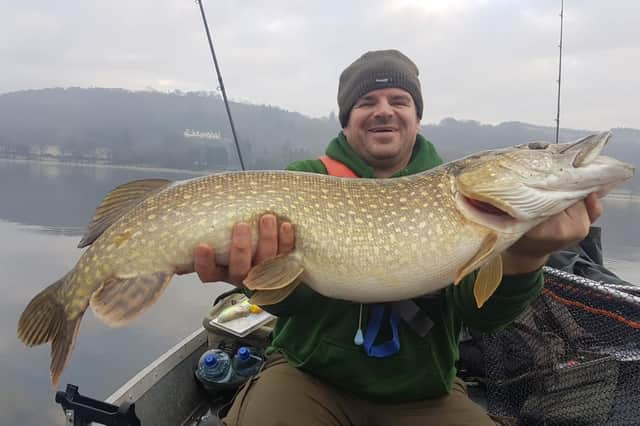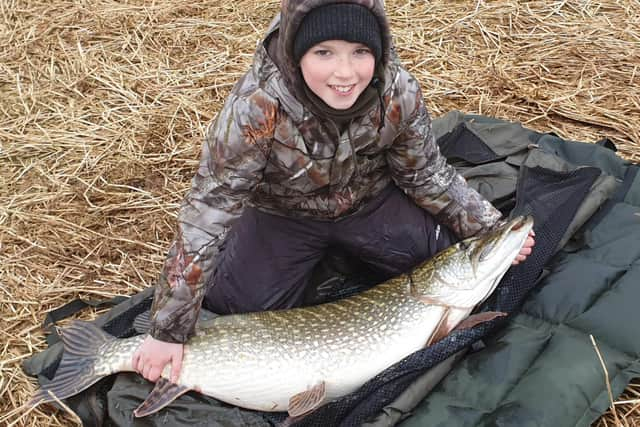Fishing: Anglers must take every precaution when fishing for ferocious pike


Most pikers leave lure fishing for the spring and early autumn and employ static dead-baiting throughout the winter.
Pike are ferocious predators but once out of the water they are prone to damage caused by bad handling and anglers must take every precaution not to injure the fish, or themselves.
Advertisement
Hide AdAdvertisement
Hide AdLong-nosed pliers, forceps, long-nosed side-cutters capable of cutting hooks, an unhooking mat and a large rubber mesh net are musts and Chalmers said: "Don’t even think about going piking without these items."


For general dead-baiting on the majority of Scottish lochs and reservoirs, a 12ft rod with a test curve of three to three-and-a-half pounds is perfect.
Many carp anglers, he said, already possess a suitable rod but, for smaller venues, like the Union Canal in Edinburgh, a decent spinning rod will suffice.
Quality rods are available from manufacturers like PikePro, Savage Gear, Fox and Daiwa with prices starting around £60.
Advertisement
Hide AdAdvertisement
Hide AdFixed spool reels, in sizes 6500 up to 10000, are ideal. If possible, said Chalmers, source a model with a baitrunner facility. Although not vital for static dead-baiting, they are useful, especially if anglers intend to fish from a boat.
Try not to skimp on the reel, he said, as you may regret it just when it matters most, and most pikers fill their reels with a quality braid with a breaking strain of around 65lbs.
The extra strength will allow you to bully pike away from snags or, if you do become snagged, allow you to bend the hooks out. You will also be able to play the pike to the bank without prolonging the fight and thereby reducing stress to the fish.
It is vital the angler is aware the moment a pike shows interest. If left to its own devices, a pike will swallow the bait, and hooks, resulting in a dead pike.
Advertisement
Hide AdAdvertisement
Hide AdStrike into the fish as soon as it picks up the bait. Pike normally pick a bait up sideways on, leave it too long and the pike will turn the bait in its mouth and swallow it. If you strike early the hooks will be in the front part of the mouth, making unhooking easier.
The most common method of bite indication is an alarm with a drop-back indicator which comes into play when the pike swims towards the angler.
Alarms can cost upwards of £100, but basic models can be bought for less than £10. A pair of bank sticks, one to sit the butt of the rod on and the other to hold the alarm, are required.
For canal fishing, a sliding float rig can be used, advised Chalmers. Tie a sliding stop knot (or attach a rubber float stop) on to the main line, followed by a bead, a pike float, weight, a quick release swivel and a wire trace with twin treble hooks.Before attaching the wire trace, clip a weight onto the swivel and cast to your chosen area. If the float sinks, move your stop knot further up the line until the float is just sitting at the surface.
Advertisement
Hide AdAdvertisement
Hide AdMove the stop knot up the line by a further 30cm so the float is set that much over-depth. Similarly, if you cast out and the float is sitting on the surface, move your stop knot down the line until you reach the desired depth.
Unclip the heavy weight and clip on your trace and repeat these actions when moving to a new swim.
Watch the float like a hawk. When a pike picks up the bait the float should sit upright, or move along the surface and then sink as the fish moves away.
Traces should be around 45cm and armed with twin trebles in sizes 4 or 6. Buy a quality trace from a specialist manufacturer like Scottish-based company, Gadda Baits.
Advertisement
Hide AdAdvertisement
Hide AdLive-baiting is illegal in Scotland but virtually any dead fish will catch pike but the most popular are oily baits like sardines, mackerel, whole or halved (depending on size), herring and trout.
Smelt, lamprey, eels (responsibly sourced) and pollan can be used and all these baits are available frozen. Sardines are perfectly sized baits.
Pikenote
The Pike Anglers Alliance for Scotland (PAAS) have exclusive access on several waters, including Linlithgow Loch, and hold events throughout the year. Adult membership is £22 and includes copies of the member’s magazine, Esox Scotland, and access to a members-only page on Facebook. Beginners are welcome. Visit www.esoxscotland.co.uk or email the membership secretary, Blair Davidson, at [email protected]
And another thing
Chris Empson from Dunbar won round seven of the Bass Rock Shore Angling League winter League with two fish for 3lb 13oz with Jamie McHale from Gifford second with a fish of 2lb.
Advertisement
Hide AdAdvertisement
Hide AdHigh winds and a big sea with lots of weed troubled the entrants as did eight foot rollers. The Christmas Hamper match is on Wednesday, December 15 at a venue to be decided.
Elsewhere, Carnoustie-based Kevin Lewis beat a field of 22 to win the second round of Mike and Chris' Heaviest Cod League at Arbroath with 15lb 14oz. All were cod.
Billy Buckley (Glasgow) was second with 12lb 3oz and Dalkeith-based Mike Kyle was a close third with 11lb 10oz.
The heaviest fish was landed by Buckley, a 6lb 14oz specimen, and this is the heaviest fish caught in the cod league so far.
Advertisement
Hide AdAdvertisement
Hide AdOrganiser Mike Horn said it was very windy on the day with calm seas and a huge tide which maybe caused the poor bags overall. Best bait was blueys, peeler and mussels.
Finally, coarse fishing, and Chris Paton continues to lead the Magiscroft Silver Series sponsored by Del's Fresh Produce thanks to a second first place finish in the second round of the event with 3lb 14oz netted on a freezing cold day. Fife-based Gus Brindle was second with 3lb 11oz and Dave McAuley third on 3lb 8oz.
Overall, McAuley is second and James Woodrow third, Brindle is fourth with Barry Lindsay fifth and Scott McGhee, a member of the Edinburgh and Lothians Coarse Angling Club, sixth. The next round is on Sunday, December 19.